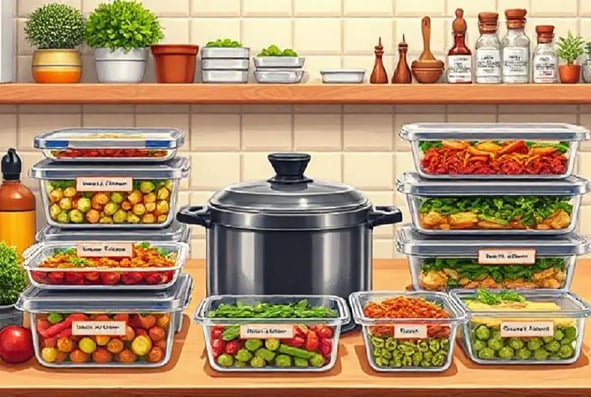
How to Scale Recipes for Multiple Days Without Compromising Quality
Discover how to maintain flavor, texture, and freshness when scaling recipes for multiple days with tips on ingredient adjustments, storage, and reheating. Perfect for meal prep!
MEAL PREP PLANNING
Mae Ellison
2/22/20255 min read


How to Maintain Quality While Scaling Recipes for Multiple Days
Introduction: Why Quality Matters in Scaled Recipes
Whether you’re prepping meals for the week ahead, cooking for a crowd, or simply looking to save time in the kitchen, scaling recipes is an incredibly useful skill. However, when cooking in large quantities, maintaining the same level of quality you’d expect from a smaller batch can be a real challenge. From preserving texture and flavor to ensuring each meal stays fresh, there’s a delicate balance to strike.
One common pitfall is overcooking or drying out food—especially when you’re trying to make enough to feed a family for several days or even a whole week. Similarly, when cooking in bulk, flavors can sometimes get lost, or the dish may not reheat as well as it did on the first day. So, how do you scale recipes without sacrificing taste, texture, or freshness?
In this post, we’ll walk you through practical tips and techniques for maintaining quality while scaling up your favorite recipes, from ingredient adjustments to storing and reheating meals. Whether you're a meal prep pro or just starting out, these strategies will help you ensure your meals stay just as delicious on Day 5 as they did on Day 1. Let’s dive in!
Understanding the Basics of Recipe Scaling
How to Adjust Ingredients Proportionally
When scaling a recipe for multiple days, it's crucial to adjust the quantities of ingredients properly to maintain the flavor, texture, and overall balance of the dish. Simply multiplying everything by a certain factor doesn’t always work, as some ingredients (like spices, herbs, or liquids) don’t scale linearly.
Use a Recipe Scaling Calculator
One of the easiest ways to adjust ingredients is by using a recipe scaling calculator, which will automatically recalculate the measurements based on how many servings you want to make. This can save you time and ensure accuracy, especially when scaling for a large crowd or several days of meals.
Adjust Spices and Seasonings in Stages
While you might think doubling or tripling the amount of seasoning is the way to go, larger batches often need less seasoning per portion to avoid overwhelming the flavor. When scaling recipes, add spices and seasonings gradually and taste frequently. For instance, if a recipe calls for 1 teaspoon of chili flakes in a small batch, you may want to start with 1.5 teaspoons in a large batch and adjust further if needed. This will prevent over-seasoning and allow you to keep the dish balanced.
Account for Differences in Cooking Methods
Certain ingredients react differently when cooked in bulk. For example, the amount of liquid needed may change when scaling recipes like soups, stews, or sauces. Larger batches tend to cook down more quickly, so you might need to add extra liquid to avoid drying out. Similarly, some vegetables might release more water when cooked in bulk, so the recipe might need adjustments in cooking time or ingredient ratios.
How to Maintain Flavor and Texture in Large Batches
Tips for Retaining Freshness and Moisture
When scaling recipes, especially for meal prep or cooking for multiple days, it's essential to preserve the moisture and freshness of your meals. Overcooking or drying out food is a frequent issue, but with the right techniques, you can prevent it. Adding broths and sauces helps lock in moisture and enhance flavor.
Use Broths and Sauces
For dishes that need extra moisture, such as casseroles or stews, consider incorporating more broths, stocks, or sauces when scaling up. These additions will help maintain moisture and improve the dish's overall flavor profile. You can also incorporate extra olive oil or butter to enhance richness without overpowering the dish.Avoid Overcooking
Large portions may take longer to cook, but it’s crucial not to overdo it. Overcooking leads to dry, unappetizing food. Keep an eye on your dish’s doneness, especially when reheating, and use a food thermometer to ensure meats are cooked perfectly but not overdone.Cooking Techniques for Retaining Texture
To keep the texture intact, opt for methods like slow cooking, steaming, or blanching. These techniques help maintain the natural texture of the ingredients without breaking them down too much during the cooking process. For example, slow cooking allows the flavors to blend without over-softening vegetables or proteins.
Storing and Preserving Scaled Recipes
How to Store Meals for Longevity
Proper storage is crucial for maintaining the quality of your meals when scaling recipes for several days. Storing food incorrectly can lead to loss of texture, flavor, and nutrients over time and could even cause food spoilage.
Invest in Airtight Containers
Airtight containers are essential for keeping meals fresh for extended periods. They seal out air and lock in moisture, helping to maintain both flavor and texture. For meal prep, choose BPA-free, microwave-safe, and dishwasher-safe containers that come in a variety of sizes. Glass containers are a great option since they are non-reactive and provide better storage than plastic, especially for acidic foods.Label and Date Each Meal
Labeling containers with the date and meal name is vital for keeping track of freshness. This ensures that you’re using meals in the correct order and helps prevent food waste. If you're freezing meals, make sure the container is marked with both the date it was made and any relevant reheating instructions.Store Ingredients Separately When Possible
If you’re prepping meals that will be eaten over several days, it’s often best to store certain components separately. For example, store salads, grains, or proteins separately from sauces or dressings to avoid sogginess. This way, the texture of each ingredient stays intact, and you can combine them right before serving or reheating.
Reheating for Consistency and Quality
Reheat Dishes Gently to Maintain Flavor
Reheating meals correctly is just as vital as cooking them properly from the start. If you don't reheat your meals carefully, you could lose moisture, texture, and flavor. Here’s how to keep your meals tasting fresh after multiple days of storage.
Use Low Heat for Even Reheating
Whether reheating in the microwave or on the stovetop, using low heat and a slow approach is essential. This ensures that the meal heats evenly without overcooking the outer layers or drying out the dish. When using the microwave, cover the dish with a microwave-safe lid or a damp paper towel to retain moisture. Stirring halfway through can also help ensure even heating. It's best to reheat dishes in their original cooking vessel.Reheat Dishes in Their Original Cooking Vessel
Whenever possible, reheat food in the same pan or pot you originally cooked it in. This helps preserve the texture of the dish, particularly when reheating large batches of stews, soups, or casseroles. When reheating on the stovetop, keep the heat low and add a splash of extra liquid (broth or water) to keep the dish from drying out.Don’t Over-Reheat
Overheating food can make it rubbery, dry, or lose its flavor. Only reheat what you need and try to avoid reheating multiple times. Ideally, meals should be reheated once and consumed that day to maintain the best taste and texture.
Typical Mistakes to Avoid When Scaling Recipes
Underestimating Cooking Time
When scaling recipes, it's easy to think that larger quantities mean more time in the oven or on the stove. However, cooking times often need to be adjusted carefully, as larger portions may cook unevenly. Overestimating the cooking time can lead to overcooked or burnt food.
Monitor Cooking Progress Closely
Always check the progress of your dish as it cooks. Use a food thermometer to check the meat and ensure the vegetables are not overcooked. Start with the recommended cooking time for a smaller batch and adjust as necessary for larger quantities.
Skipping Taste Testing During Scaling
Flavors may intensify or change as you scale a recipe, so it’s crucial to taste the dish as you go along. This ensures that the seasoning and balance remain consistent, and you’re not overdoing it with spices or other strong flavors.
Conclusion: Keep Your Meals Delicious and Consistent
Scaling recipes for multiple days doesn’t have to mean sacrificing flavor, texture, or freshness. By adjusting ingredients carefully, using the right cooking methods, and storing your meals properly, you can ensure that each dish stays as delicious as the first. Remember to reheat carefully and avoid common mistakes to make your meal prep or cooking experience as successful as possible.
